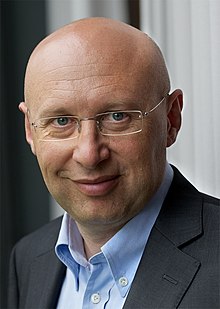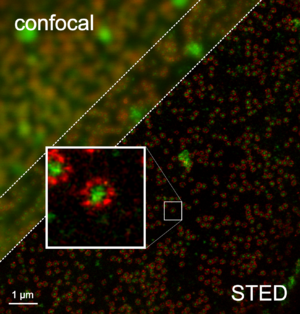| Revision as of 20:27, 12 October 2023 editPrimeBOT (talk | contribs)Bots2,066,063 editsm →top: Task 30: parameter removal following discussionTag: AWB← Previous edit | Revision as of 20:15, 26 November 2023 edit undoUlrikelovesscience (talk | contribs)Extended confirmed users821 editsNo edit summaryNext edit → | ||
| Line 18: | Line 18: | ||
| | thesis_year = 1990 | | thesis_year = 1990 | ||
| | doctoral_students = | | doctoral_students = | ||
| | notable_students = ] (postdoc) <br>] (postdoc) | |||
| | occupation = Physicist | | occupation = Physicist | ||
| | years_active = | | years_active = | ||
Revision as of 20:15, 26 November 2023
Romanian-German physicist (born 1962)| Stefan Walter Hell | |
|---|---|
 Hell in 2010 Hell in 2010 | |
| Born | (1962-12-23) 23 December 1962 (age 62) Arad, Romania |
| Citizenship | Germany Romania |
| Alma mater | Heidelberg University |
| Occupation | Physicist |
| Known for | STED microscopy RESOLFT GSD microscopy 4Pi microscope Multifocal multiphoton microscopy Three photon microscopy |
| Awards | Nobel Prize in Chemistry (2014) Kavli Prize in Nanoscience (2014) Otto Hahn Prize (2009) Gottfried Wilhelm Leibniz Prize (2008) |
| Scientific career | |
| Fields | Physical chemistry |
| Institutions | European Molecular Biology Laboratory Max Planck Institute for Biophysical Chemistry German Cancer Research Center |
| Thesis | Imaging of transparent microstructures in a confocal microscope (1990) |
| Doctoral advisor | Siegfried Hunklinger [de] |
| Notable students | Ilaria Testa (postdoc) Francisco Balzarotti (postdoc) |
Stefan Walter Hell HonFRMS (Template:IPA-de: born 23 December 1962) is a Romanian-German physicist and one of the directors of the Max Planck Institute for Biophysical Chemistry in Göttingen, Germany. He received the Nobel Prize in Chemistry in 2014 "for the development of super-resolved fluorescence microscopy", together with Eric Betzig and William Moerner.

Life
Born into a Roman Catholic Banat Swabian family in Arad, Romania, he grew up at his parents' home in nearby Sântana. Hell attended primary school there between 1969 and 1977. Subsequently, he attended one year of secondary education at the Nikolaus Lenau High School in Timișoara before leaving with his parents to West Germany in 1978. His father was an engineer and his mother a teacher; the family settled in Ludwigshafen after emigrating.
Hell began his studies at the Heidelberg University in 1981, where he received his doctorate in physics in 1990. His thesis advisor was the solid-state physicist Siegfried Hunklinger. The title of the thesis was “Imaging of transparent microstructures in a confocal microscope”. He was an independent inventor for a short period thereafter working on improving depth (axial) resolution in confocal microscopy, which became later known as the 4Pi microscope. Resolution is the possibility to separate two similar objects in close proximity and is therefore the most important property of a microscope.
From 1991 to 1993, Hell worked at the European Molecular Biology Laboratory in Heidelberg, where he succeeded in demonstrating the principles of 4-Pi microscopy. From 1993 to 1996 he worked as a group leader at the University of Turku (Finland) in the department for Medical Physics, where he developed the principle for stimulated emission depletion STED microscopy. From 1993 to 1994 Hell was also for 6 months a visiting scientist at the University of Oxford (England). He received his habilitation in physics from the University of Heidelberg in 1996. On 15 October 2002, Hell became a director of the Max Planck Institute for Biophysical Chemistry in Göttingen and he established the department of Nanobiophotonics. Since 2003 Hell has also been the leader of the department "Optical Nanoscopy division" at the German Cancer Research Center (DKFZ) in Heidelberg and "non-budgeted professor" (apl. Prof.) in the Heidelberg University Faculty of Physics and Astronomy. Since 2004 he has been an honorary professor for experimental physics at the faculty of physics of the University of Göttingen.
With the invention and subsequent development of Stimulated Emission Depletion microscopy and related microscopy methods, he was able to show that one can substantially improve the resolving power of the fluorescence microscope, previously limited to half the wavelength of the employed light (> 200 nanometers). A microscope's resolution is its most important property. Hell was the first to demonstrate, both theoretically and experimentally, how one can decouple the resolution of the fluorescence microscope from diffraction and increase it to a fraction of the wavelength of light (to the nanometer scale). Ever since the work of Ernst Karl Abbe in 1873, this feat was not thought possible. For this achievement and its significance for other fields of science, such as the life-sciences and medical research, he received the 10th German Innovation Award (Deutscher Zukunftspreis) on 23 November 2006. He received the Nobel Prize in Chemistry in 2014, becoming the second Nobelist born in the Banat Swabian community (after Herta Müller, the 2009 recipient of the Nobel Prize in Literature).
As of 2021, Hell has an h-index of 132 according to Google Scholar.
Awards
- Prize of the International Commission for Optics, 2000
- Helmholtz-Award for metrology, Co-Recipient, 2001
- Berthold Leibinger Innovationspreis, 2002
- Carl-Zeiss Research Award, 2002
- Karl-Heinz-Beckurts-award, 2002
- C. Benz u. G. Daimler-Award of Berlin-Brandenburgisch academy, 2004
- Robert B. Woodward Scholar, Harvard University, Cambridge, MA, USA, 2006
- Innovation Award of the German Federal President, 2006
- Julius Springer Prize for Applied Physics, 2007
- Member of the Akademie der Wissenschaften zu Göttingen, 2007
- Gottfried Wilhelm Leibniz Prize, 2008
- Lower Saxony State Prize, 2008
- Nomination for European Inventor of the Year of the European Patent Office, 2008
- Method of the year 2008 in Nature Methods
- Otto-Hahn-Preis, 2009
- Ernst-Hellmut-Vits-Prize, 2010
- Hansen Family Award, 2011
- Körber European Science Prize, 2011
- The Gothenburg Lise Meitner prize, 2010/11
- Meyenburg Prize, 2011
- Science Prize of the Fritz Behrens Foundation 2012
- Doctor Honoris Causa of Vasile Goldiș Western University of Arad, 2012
- Romanian Academy, Honorary Member, 2012
- Paul Karrer Gold Medal, University of Zürich, 2013
- Member of German National Academy of Sciences Leopoldina, 2013
- Carus Medal [de] of the Leopoldina, 2013
- Kavli Prize, 2014
- Nobel Prize in Chemistry, 2014
- Romanian Royal Family: Knight Commander of the Order of the Crown, 2015
- Romania: Grand Cross of the Order of the Star of Romania, 2015
- Glenn T. Seaborg Medal, 2015
- Wilhelm Exner Medal, 2016
- Foreign associate of the National Academy of Sciences, 2016
- Honorary Fellow of the Royal Microscopical Society (HonFRMS) for his contributions to microscopy, 2017
- Fellow of the Norwegian Academy of Science and Letters.
- Pour le Mérite, 2022
Publications
- Balzarotti, F.; Eilers, Y.; Gwosch, K.; Gynnå, A. H.; Westphal, V.; Stefani, F. D.; Elf, J.; Hell, S. W. (2017). "Nanometer resolution imaging and tracking of fluorescent molecules with minimal photon fluxes". Science. 355 (6325): 606–612. arXiv:1611.03401. Bibcode:2017Sci...355..606B. doi:10.1126/science.aak9913. PMID 28008086. S2CID 5418707.
- Butkevich, A.; Mitronova, G.; Sidenstein, S.; Klocke, J.; Kamin, D.; Meineke, D. N. H.; D'Este, E.; Kraemer, P. T.; Danzl, J. G.; Belov, V. N.; et al. (2016). "Fluorescent rhodamines and fluorogenic carbopyronines for super-resolution STED microscopy in living cells". Angewandte Chemie International Edition. 55 (10): 3290–3294. doi:10.1002/anie.201511018. PMC 4770443. PMID 26844929.
References
- "Homepage". www.mpibpc.mpg.de. Retrieved 11 June 2017.
- ^ "Nobelprize.org". Retrieved 11 June 2017.
- (in Romanian) Răzvan Băltăreţu, "Un cercetător născut în judeţul Arad este printre câştigătorii premiului Nobel pentru chimie", Adevărul, October 8, 2014
- Andreea Ofiţeru, "Stefan W. Hell, pentru Gândul: 'Am avut profesori extraordinari în România'", Gândul, October 9, 2014
- ^ (in Romanian) Andreea Pocotila, "Fizicianul premiat cu Nobelul pentru chimie vorbește românește și ține legătura cu mediul științific din țara noastră", România Liberă, October 8, 2014
- (in Romanian) Ștefan Both, "Stefan W.Hell, al doilea elev de la Liceul 'Nikolaus Lenau' din Timişoara care a câştigat un Nobel", Adevărul, October 8, 2014
- "Curriculum Vitae". Archived from the original on 25 October 2007. Retrieved 11 June 2017.
- "NanoBiophotonics – Stefan W. Hell's Personal Profile". www.mpibpc.gwdg.de. Retrieved 11 June 2017.
- ^ "Deutscher Zukunftspreis". Archived from the original on 25 October 2007. Retrieved 11 June 2017.
- "MPI für biophysikalische Chemie: Hell für Deutschen Zukunftspreis 2006 nominiert". www.mpibpc.mpg.de. Retrieved 11 June 2017.
- "Max film" (PDF). Retrieved 11 June 2017.
- "CV of Stefan Hell" (PDF). Academy of Sciences Leopoldina. Retrieved October 9, 2014.
- "Hell, Stefan, Prof. Dr. Dr. h.c. mult". Göttingen Graduate School for Neurosciences, Biophysics, and Molecular Biosciences. Retrieved 2015-12-03.
- Stefan Hell publications indexed by Google Scholar

- Office, European Patent. "Mission Impossible: Breaking the Visual Barrier". www.epo.org. Retrieved 11 June 2017.
- "Course of science". Bayer Foundation. Retrieved 2021-12-15.
- Stefan Hell – Körber-Preisträger 2011 Archived 2014-10-13 at the Wayback Machine
- "From microscopy to nanoscopy: 2011 Meyenburg Award goes to Stefan Hell". www.dkfz.de. Retrieved 11 June 2017.
- "STEFAN W. HELL, Doctor Honoris Causa al Universitatii de Vest "Vasile Goldis"". 9 October 2014. Retrieved 11 June 2017.
- "Imagini de la evenimentul dedicat laureatului Premiului Nobel, Ștefan Hell – Familia Regală a României / Royal Family of Romania". www.romaniaregala.ro. Retrieved 11 June 2017.
- "Laureat al Premiului Nobel decorat de Regele Mihai – Familia Regală a României / Royal Family of Romania". www.romaniaregala.ro. Retrieved 11 June 2017.
- (in Romanian) Ștefan Pană, "Stefan Hell, laureat al Nobel, a fost decorat de Iohannis", Mediafax, September 4, 2015
- "New Physico-Chemical Tools for New Biology". UCLA. Retrieved 9 November 2015.
- "Awardees". Wilmelm Exner Stiftung. Retrieved 12 April 2017.
- National Academy of Sciences Members and Foreign Associates Elected, News from the National Academy of Sciences, National Academy of Sciences, May 3, 2016, retrieved 2016-05-14.
- "Honourary Fellows". www.rms.org.uk. Retrieved 18 December 2017.
- "Group 2: Astronomy, Physics and Geophysics". Norwegian Academy of Science and Letters. Archived from the original on 22 December 2017. Retrieved 22 December 2017.
- "Hell". ORDEN POUR LE MÉRITE (in German). Retrieved 11 June 2023.
External links
- Chemistry Tree: Stefan W. Hell Details
- Curriculum vitae on the Website of Max Planck Institute for Biophysical Chemistry
- Stefan Hell Lecture: Super-Resolution: Overview and Stimulated Emission Depletion (STED) Microscopy, May 2013
- Innovation Award of the German Federal President
- List of articles from Steffan Hell
- Stefan Hell on Nobelprize.org

| 2014 Nobel Prize laureates | |
|---|---|
| Chemistry |
|
| Literature (2014) |
|
| Peace (2014) |
|
| Physics |
|
| Physiology or Medicine |
|
| Economic Sciences |
|
- Living people
- 1962 births
- Gottfried Wilhelm Leibniz Prize winners
- 21st-century German physicists
- Heidelberg University alumni
- People from Arad, Romania
- Danube-Swabian people
- Max Planck Society people
- 21st-century German chemists
- Microscopists
- German Nobel laureates
- Nobel laureates in Chemistry
- German people of German-Romanian descent
- Romanian Nobel laureates
- Honorary members of the Romanian Academy
- Honorary Fellows of the Royal Microscopical Society
- Recipients of the Order of the Crown (Romania)
- Commanders of the Order of the Crown (Romania)
- Grand Crosses of the Order of the Star of Romania
- Foreign associates of the National Academy of Sciences
- Knights Commander of the Order of Merit of the Federal Republic of Germany
- Recipients of the Order of Merit of Baden-Württemberg
- Members of the Norwegian Academy of Science and Letters
- Kavli Prize laureates in Nanoscience
- Members of the Göttingen Academy of Sciences and Humanities
- Max Planck Institute directors
- Fellows of the American Physical Society
